Agencies often see their hard-earned cash slip through the cracks due to poor project management. Whether the cause is inefficient processes, ineffective resource management or a lack of tools for real-time project tracking, agencies are struggling to balance client expectations with team capacity.
How is that possible? Unfortunately, this seems to be a common issue that leads to missed deadlines, scope creep, and over-or-under allocation of resources that eventually eat away at your profit margin.
If your business is facing the same problem, you’re in the right place, because we’re taking a closer look at what effective agency project management actually looks like.
Considering you already picked perfect project management software for agency, we give you the seven steps you need to take to stop losing revenue.
Step 1: Determine project scope
The first step is to pin down exactly what the project will deliver, and what it will not. For any type of service business dealing with projects such as marketing campaigns or product launches, vague or shifting project scope is a recipe for disaster.
To avoid this, you need to construct a complete Work Breakdown Structure (WBS). For creative agencies, they can be presented in the following formats:
- Hierarchical tree – Using design tools, WBS templates or PowerPoint presentations
- Spreadsheet – Using tabular tools like Google Sheets or Excel
- Task boards – Using Kanban-style task boards found in some project management tools like ActiveCollab
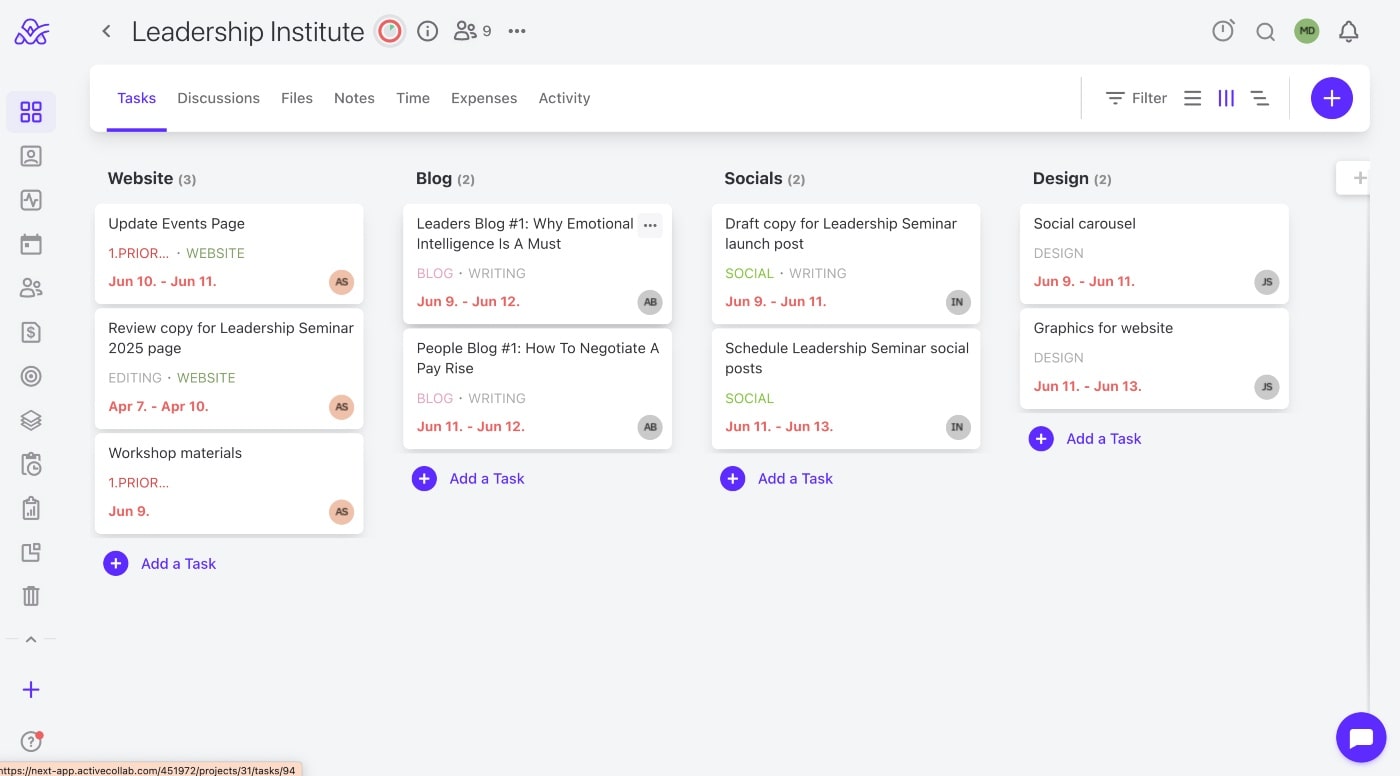
When determining project scope, there are a couple of bases you should cover:
- Involve all stakeholders to get clarity around deliverables, tasks, subtasks and dependencies
- Define deliverables in detail early to avoid costly errors, timeline mishaps, and budget overruns
Proper project scoping gives your team the opportunity to address uncertainties early and set a firm foundation, so you don't have to scramble into risk management mode mid-project.
Step 2: Establish team capacity
Step two is establishing your team's actual capacity. This is a vital element of productivity and resource planning for agencies. It's all about understanding exactly what each team member can do, what their availability is, and what their strengths are when it comes to getting client work done on time.
Many agencies get into trouble by overpromising before they've establishing if their team has the bandwidth. This can be a serious business risk on several fronts because it results in:
- Rushed, low-quality work
- Missed deadlines
- Increased stress and team burnout
- Damaged client relationships
To avoid this list, it's critical to start doing capacity planning. This will make sure you have a realistic view of how much work your writers, designers and developers can do in a given timeframe.
For basic capacity planning follow the following steps:
- Work out your entire team's available capacity baseline per employee
- Evaluate current business demand and deduct from the baseline
- See how much available capacity each team member has to take on additional or new project work
If the project scope exceeds your team's available capacity baseline for one or more team members, you'll need to either extend the new project's timeline for when they are available or consider brining on a freelancer or contractor to fill the capacity gap.
Tools like ActiveCollab simplify workforce capacity planning for agencies. By letting you set daily individual capacities and having your team track task time, you can view real-time workload dashboards to inform your project decisions.
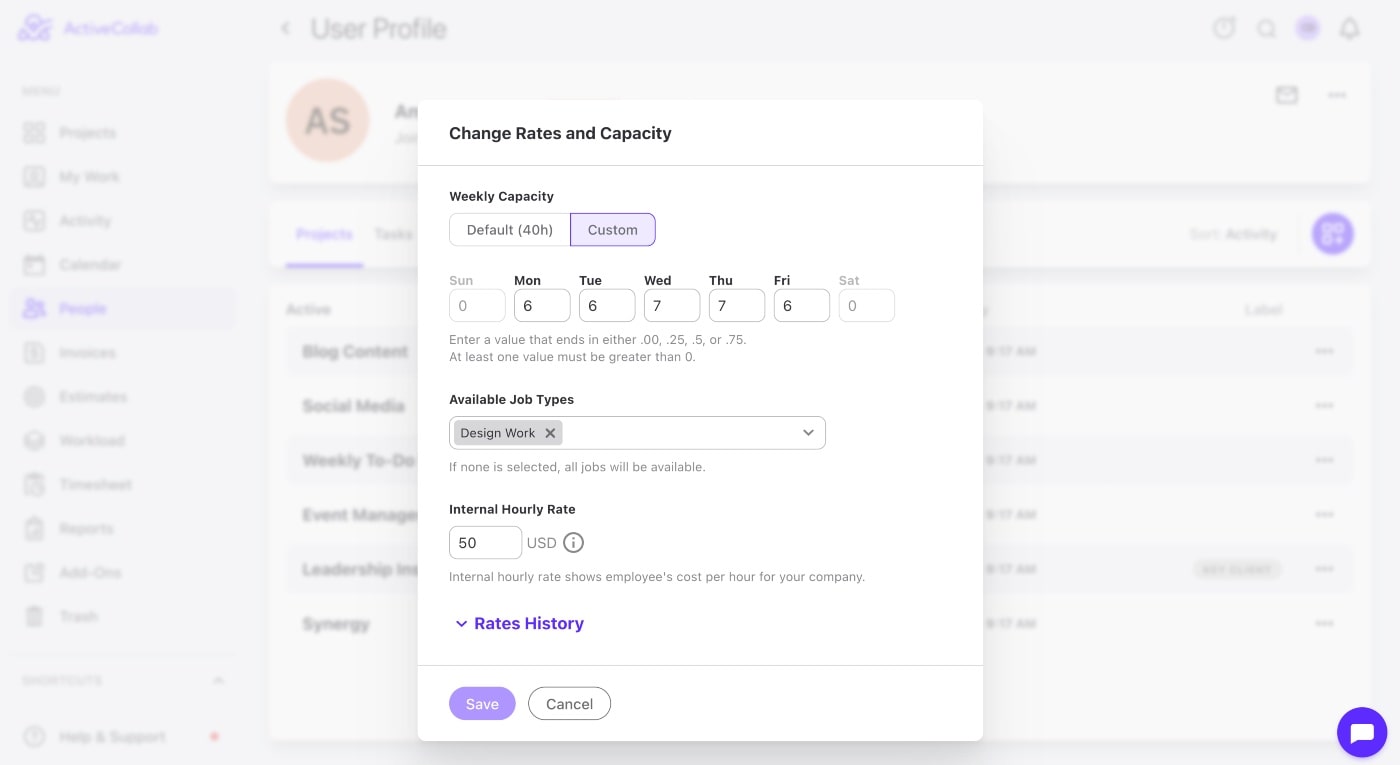
These dashboards show in exact hours if an employee is under capacity (not being utilized enough and has time to take on more work), over capacity (being utilized too much and at risk of burnout) or whether your business is at an ideal workload balance.
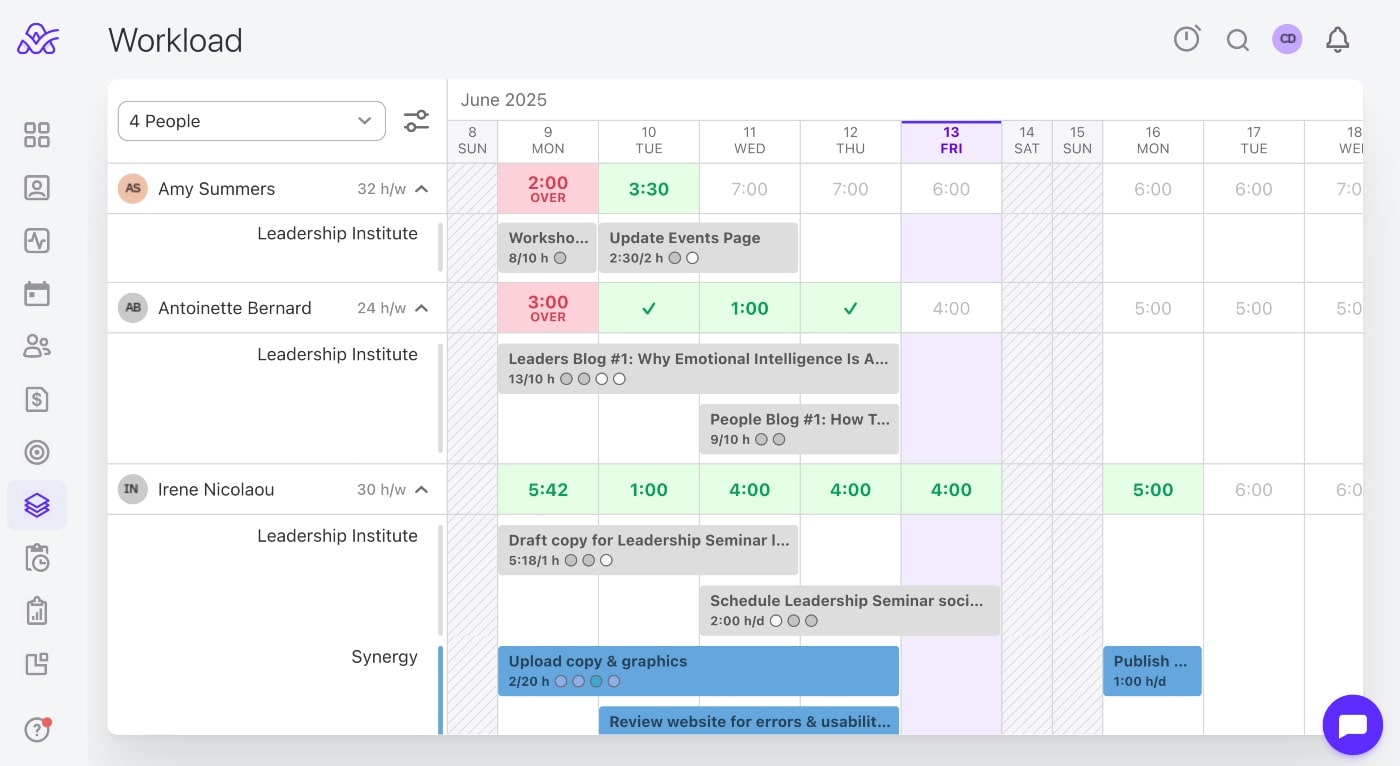
When you establish your team's true capacity upfront, you can plan a project that is ambitious, yet still achievable.
Step 3: Allocate resources & assign tasks
With a detailed overview of everything that needs to be done, the next step is to decide which team member will be doing what, as well as when.
For agency project management, the key to success in this step lies in allocating resources strategically.
Here's how to approach it:
- Put your most crucial and urgent client work first: Prioritize the most important and challenging tasks first. The same goes for projects.
- Assign the right people to each task or project: This means taking into account their availability, skill set, and experience, as well as strengths and preferences.
- Talk to your team: The only surefire way to gauge your resources is to talk to your team and learn how much bandwidth they really have. After all, they know their workload and abilities best, but asking for their input also helps empower them.
Step 4: Set realistic client expectations
You want your agency to be as productive as possible, and that should go without saying. However, some project managers, eager to get the best out of their teams, overpromise their clients and set expectations so high that teams cannot possibly reach them.
This not only leads to client disappointment but also has a negative impact on the well-being and mental health of team members.
On top of that, if the only way to keep your clients is by offering a lot more for less, it’s just a spiral of diminishing returns.
A better way of going about it would be to be transparent about what's possible given the project scope, budget and your team's capacity.
Here are a couple of things to keep an eye out for so you don't overpromise:
- Weigh up before you say "yes" to faster delivery times or extra features
- Instead of overly optimistic, go for realistic timelines with slack time built in
- It's always better to underpromise and overdeliver than vice verser
- Use previous projects to back your case when needing to push back
- When changes are made mid-project be candid about the impact to the rest of the deliverables
Remember, saying yes to every request and trying to please your client at every whim, is not a sustainable strategy for any service business.
Step 5: Communicate often, be clear & concise

Once you have everything set up, it’s crucial that you keep everyone on the same page, especially if there are changes or new developments on your client project. Make sure to remain accessible to your team members and clients if they have questions, doubts, or problems.
Some things you can do to promote and foster project collaboration and communication includes:
- Create a communication plan and send out regular updates
- Establish which communication channels should be used for different types of interactions (casual conversations and queries/formal requests)
- Respond to comments and queries in a timely manner
- Summerize action items post meetings
- Make project information accessible
For agencies juggling multiple client projects, frequent, clear and real time communication is essential to keep everyone involved perfectly aligned.
This can be achieved easily with integrated agency project management tools that let you track workflows, collaborate and discuss progress within tasks, and track time and budgets in one centralized platform like ActiveCollab.
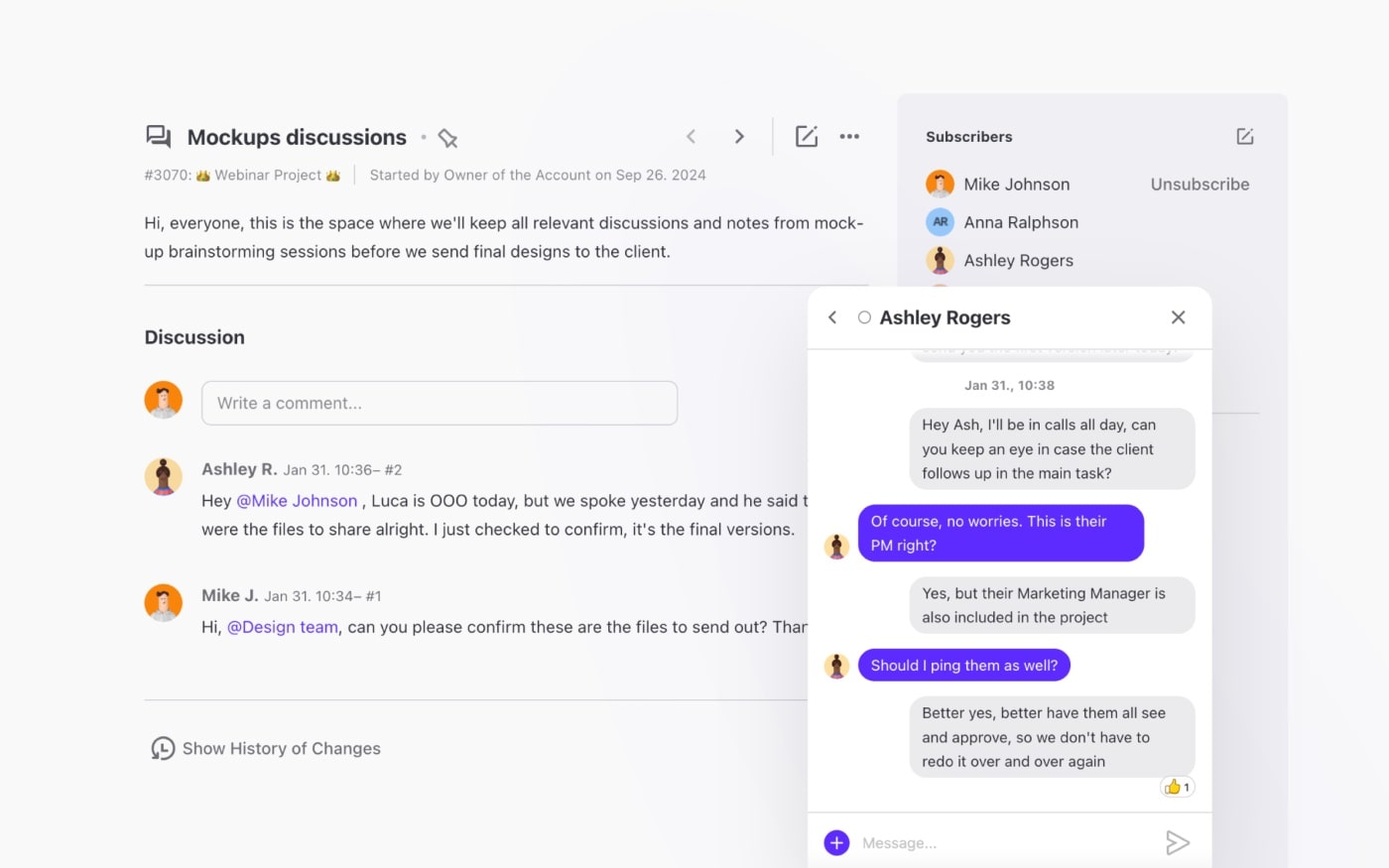
Step 6: Monitor, spot challenges & minimize inefficiencies
When you've ticked the boxes for all of the above steps, it's vital you don't undermine the importance of regular project monitoring. If you don't actively track your progress and make it a habit to spot challenges early on, small issues can snowball creating serious project delays.
Here are the things you need to keep a close eye on:
- Time data logs – Make sure you team is logging time for every task so you can identify inefficiencies and make necessary adjustments
- Bottlenecks & blockers – You might be waiting for a task to start because the owner is stuck on another client project, or you're waiting on client feedback longer than you should be
- Multi-tasking – Keep an eye out for team members with lots of work on who might be multi-tasking as this can be severely draining, leading to lost focus and low quality deliverables
Agency project management tool can simplify this step for account and client managers through project dashboards and reports like the ones ActiveCollab offers. With the click of a button, project overviews let you see a number of vital project health metrics instantly. These include task completion rates, estimated against tracked time, proportion of billable and unbillable work, budget spend and overall project profitability.
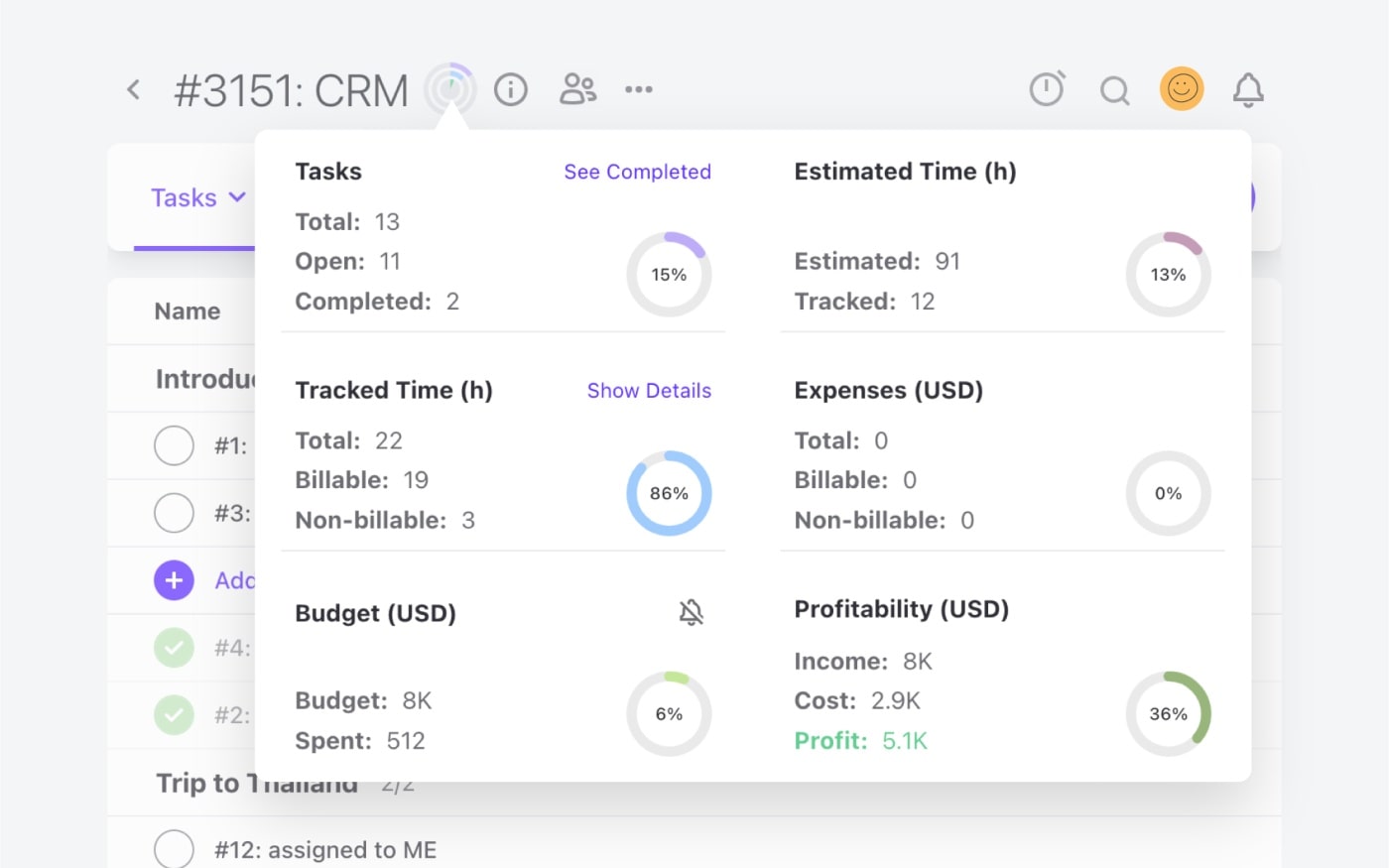
Step 7: Make adjustments
Project management is a process, not a one-time fix, which means you need to be aware of the circumstances that might require you to alter your original plan.
For example, some tasks may take more time than originally estimated, or they get delayed because they depend on other work that is taking additional time.
How do you get around this unpredictability? We suggest implementing the following tips:
- Identify overworked/underutilized team members: In case of uneven workload, redistribute it, so that overwhelmed creatives have a chance to breathe, and underutilized employees can shine.
- Adjust project deadline: Every project has a lot of moving parts, it’s not set in stone. If your team needs additional time to finish a project, consider postponing the deadline and let the client know about it, while giving them a valid explanation.
- Reprioritize work: If you come across a task that is more complex than initially appears, but still crucial to the overall project, think about prioritizing it, especially if other tasks depend on it.
If you see mid-project that your original estimates were off, or a process isn't working, don't ignore it –– act immediately and adjust. Successful agencies don't stay stuck in processes and plans that don't serve them. They thrive by tweaking and iterating their approach, constantly.
This kind of improvement mindset is what separates high-performing, strong revenue earning agencies from the mediocre ones.
Get ActiveCollab: Take agency project management to the next level
While no agency can guarantee every project will be a high-earner, you can minimize the chances of taking on low-profit clients. By carrying out proper project scoping and doing meticulous capacity and resource planning, you can make sure you maximize your agency profits.
Effective project management for agencies isn't just about avoiding failure, it's about effectively driving maximum profitability for every client project.
ActiveCollab is project management for agencies.
It helps agency project managers plan, execute and monitor client projects in one centralized platform. In the scoping phase, you can create work breakdown structures to help you work out exactly what the size of the project is and how many moving parts it has. You can group tasks into Kanban style boards, set deadlines and time estimates and assign owners to every task and subtask.
When you need to make timeline changes, simply drag and drop and all dependant tasks will update automatically. On top of that, every change made will trigger an automatic activity notifacations to every member of the project that's involved, so everyone stays in the loop at all times.
With resource and capacity management, you'll never say "yes" to a project you in reality can't deliver. The workload view helps you manage utilization by making it easy to spot if someone in your team is overbooked or if there's room to reassign tasks.
Is you're agency losing revenue?
Are you struggling with capacity planning?
And you're on the hunt for project management software that's specially crafted for agency projects?
Then you've come to the right page. Sign up for our 14-day free trial or book a demo with one of our people to see how you can manage do project management the smart agency founder way, al in one place: ActiveCollab.
